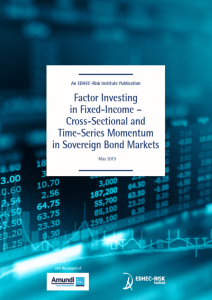

Factor Investing in Fixed-Income - Cross-Sectional and Time-Series Momentum in Sovereign Bond Markets
In this paper, “Factor Investing in Fixed-Income – Cross-Sectional and Time-Series Momentum in Sovereign Bond Markets”, we undertake a systematic, security-level analysis of momentum and reversal strategies in US Treasuries covering more than 40 years of data. We distinguish between what we call ‘market’ and ‘self’ time-series momentum (reversal) strategies, and present an exact identity between these two time-series and the cross-sectional momentum (reversal) strategies. This identity helps us identify the sources of profitability of the various strategies, and raises interesting question regarding the contribution of the first and second principal components of yield changes.
Author(s):
Summary:
Looking at momentum in fixed-income markets at the security level is very important, because studies that employ ‘synthetic’ zero-coupon bonds can be vitiated by the well-known serial autocorrelation of pricing errors, which can masquerade as a momentum effect. To our knowledge, no empirical study of momentum in Treasuries has looked at the problem at this level of granularity.
In this paper, “Factor Investing in Fixed-Income – Cross-Sectional and Time-Series Momentum in Sovereign Bond Markets”, we undertake a systematic, security-level analysis of momentum and reversal strategies in US Treasuries covering more than 40 years of data. We distinguish between what we call ‘market’ and ‘self’ time-series momentum (reversal) strategies, and present an exact identity between these two time-series and the cross-sectional momentum (reversal) strategies. This identity helps us identify the sources of profitability of the various strategies, and raises interesting question regarding the contribution of the first and second principal components of yield changes.
We find that there exist look-back and investment periods for which momentum times series strategies (both ‘self’ and ‘market’) give rise to statistically and economically significant positive Sharpe ratios. We also find that, after adjusting for duration, the reversal cross-sectional strategy has even larger Sharpe ratios, and is profitable over a wider range of look-back and investment periods. We argue that the explanation for this finding is related to the mean reverting properties of the yield-curve slope.
Finally, we show that the duration-adjusted reversal cross-sectional strategy can be successfully implemented in a long-only fashion.
Register to download PDF
Register/Log in| Type : | EDHEC Publication |
|---|---|
| Date : | 26/06/2019 |

